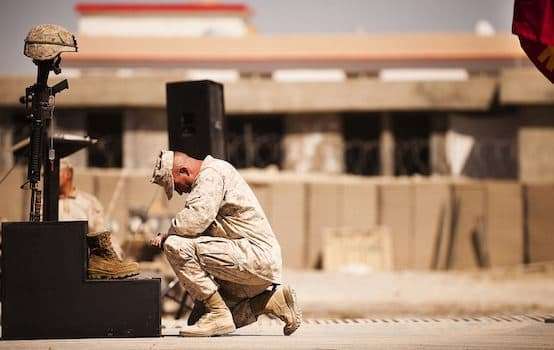
Secretary of State Mike Pompeo visited Afghanistan earlier this week and declared that U.S. strategy there “is indeed working.” Alas, evidence of success in America’s longest war is difficult to find. On Saturday, just before the secretary made his hopeful statement, an Afghan soldier killed Corporal Joseph Maciel of South Gate, California, in yet another brazen insider assault on one of our troops. The administration’s approach did not “work” for him.
After the 9/11 attacks, the U.S. had no choice but to target al-Qaeda and its Afghan host, the Taliban government. Both were quickly, if incompletely, defeated. The threat to America was largely eliminated.
Today, al-Qaeda is mostly an inspiration to local affiliates, such as al-Qaeda in the Arabian Peninsula, currently being targeted in Yemen by a heavy U.S. bombing campaign. Osama bin Laden gained sanctuary in next-door Pakistan, where American forces eventually found him. Nonexistent in 2001, the Islamic State now takes credit for many of the bloody attacks against civilians in Afghanistan today.
Although the Taliban continues to contend for power, it is just another insurgency in a world seemingly aflame. The group wants to return Afghanistan to medieval-style rule, but has few ambitions beyond that. What is left of al-Qaeda would gain nothing from a Taliban victory, since the group can operate from most anywhere in the world.
- America the Hyperpowerful
- Can We Admit Now That Afghanistan Reconstruction Failed?
In short, Washington could have claimed “mission accomplished” and brought its personnel home years ago. But it didn’t and is now—by several measures—paying the price.
Nearly 17 years, 2,400 military and 3,500 contractor deaths, and almost a trillion dollars later, U.S. forces remain on station in Central Asia. Indeed, Donald Trump has upped force levels, expanded CIA covert operations, and increased airstrikes. Overall, Washington is set to spend $45 billion in Afghanistan this year.
Despite recurring claims of progress and promises of improvement, Kabul appears little closer to standing on its own. When I visited Afghanistan as part of a NATO delegation a few years back, the private, off-the-record comments of allied military personnel, civilian contractors, and Afghans were invariably caustic and pessimistic at best.
The government there is in permanent crisis. Poppy production, which corrupts everything it touches, reached a new high last year. The number of Taliban fighters is thought to have at least tripled since 2014 to 60,000, and insurgents are active across the country, even staging attacks with night vision equipment. Kabul is unsafe, forcing the U.S. to ferry its personnel to the airport via helicopter (a route I took multiple times without incident during my visits).
The U.S. government always claims to be optimistic about Afghanistan’s future, sentiments that are either willfully blind or calculatedly fraudulent. Washington’s continuing presence is not so much about winning as not losing. Successive presidents have hoped to put off the inevitable American withdrawal and consequent Afghan collapse.
Client states sometimes show more resilience than expected—the Soviet withdrawal did not lead to the immediate end of President Mohammad Najibullah’s government. However, without U.S. troops, Afghanistan today would likely fragment and return to its natural condition, a land ruled at the village and valley level. Negotiations might create a formal national government to occupy the nation’s UN seat, but a stable, liberal, Westminster-style democracy allied with the West is a fantasy.
An enormous amount of money has been squandered on this mad attempt to promote democracy in Central Asia. Worse, U.S. military personnel, military contractors, and civilian staff have died for little reason other than protecting the reputations and ambitions of successive presidents. This is a scandalous misuse of America’s military.
Why is all of this being done? Until 2001, Washington had little interest or influence in Afghanistan. Why is Central Asia supposedly vital today?
Terrorism remains the favorite bugaboo. Newly installed U.S. commander General Austin “Scott” Miller opined: “This is about protecting U.S. citizens, when you go right to the heart of the issue.” His predecessor, General John Nicholson said: “We either keep the pressure on them here, or they bring the fight to our doorstep.” Senator Lindsey Graham argued that “Last time we ignored Afghanistan we got 9/11.”
However, Afghanistan is irrelevant to terrorists. Bin Laden’s grievances were unrelated to Afghanistan. After the U.S. invaded, he moved to Pakistan. September 11 was primarily planned by Khalid Sheikh Muhammed, who variously lived and fought in Kuwait, Bosnia, Qatar, and Pakistan—where he was captured. (In fact, he refused a request by bin Laden to move to Afghanistan.)
Even when 140,000 allied troops occupied Afghanistan, much of that country was beyond the control of Washington or Kabul. If the Taliban was in control it would not be likely to invite back the movement whose activities triggered its ouster almost two decades ago. Nor would the Taliban be sailing for the New World: it wants to govern the territory for which it has been fighting for years.
Defense Secretary Jim Mattis argued that the administration hoped to “strengthen the Afghan security forces enough to convince the insurgents that they cannot win on the battlefield, driving them to choose reconciliation.” Alas, after nearly 17 years, the Afghans appear no closer to convincing the insurgents to quit. Mattis said “We’re not there to stay forever,” but it sure looks that way. The Pentagon soon will be deploying those born after 9/11 into Afghanistan.
Of course, it would be desirable to defeat the Taliban and establish a liberal republic. But that is more preference than interest, and certainly not worth additional American lives and money. If more than 110,000 U.S. and 30,000 allied troops couldn’t achieve victory in 2011, roughly 15,000 U.S. and 7,000 allied personnel won’t win today.
Some analysts want to stabilize Pakistan. But the best way to do that would be to end the war. Whatever the convenience of possessing a couple airfields in Central Asia, their price in blood and dollars is too high.
Those who carefully study the war have little good to say about it. A BBC survey in January figured that the Taliban fully controlled 4 percent of the country and was active in another 66 percent of Afghanistan. Half of the population lived in regions where Taliban attacks were common. The insurgents had “pushed beyond their traditional southern stronghold into eastern western and northern parts of the country.”
The Special Inspector General for Afghanistan (SIGAR) John F. Spoko recently told the Senate that his staff “continues to document a disturbing amount of waste, fraud, and abuse” in U.S. aid. The examples he cited were many. The $126 billion appropriated is more, in real terms, than the Marshall Plan for Europe after World War II. (Another $750 billion has gone to combat operations.)
In its latest quarterly report in April, SIGAR noted the “highly unstable” security environment, with the most “security incidents” ever last year. The Afghan government slightly improved the share of the population it controlled during the first quarter, but remained below its share at the same time in 2017. There was a slight increase in the number of districts under government control, but the number under Taliban control also rose. The result remained “its second lowest level, and the insurgency’s at its highest level, since SIGAR began receiving district control data in November 2015.”
A recent SIGAR analysis of Washington’s stabilization program observed: “The U.S. government greatly overestimated its ability to build and reform government institutions in Afghanistan.” Alas, SIGAR found “the stabilization strategy and the programs used to achieve it were not properly tailored to the Afghan context, and successes in stabilizing Afghan districts rarely lasted longer than the physical presence of coalition troops and civilians.” Even more shocking: “The large sums of stabilization dollars the United States devoted to Afghanistan in search of quick gains often exacerbated conflicts, enabled corruption, and bolstered support for insurgents.” Overall “the program mostly failed.”
The Department of Defense’s inspector general published its latest quarterly report in May. The conclusion: “available metrics showed few signs of progress.” Overall, DOD cited UN estimates that “civilian casualties were at near-record high levels, and U.S. intelligence officials predicted that the overall security and economic situation in Afghanistan would deteriorate modestly this year.”
How can we characterize the results of nearly 17 years of war as anything but failure?
The fault lies not with those sent into battle but with policymakers who expected American and allied personnel to remake Afghanistan in the West’s image. This mission has always been a fool’s errand, conducted at tragically great cost.
The president knows what needs to be done. As a candidate he pronounced: “We made a terrible mistake getting involved there in the first place.” Before declaring for president he said simply: “Let’s get out of Afghanistan.”
Well, Mr. President, how about it?
Doug Bandow is a senior fellow at the Cato Institute and a TAC contributing editor. A former special assistant to President Ronald Reagan, he is author of Foreign Follies: America’s New Global Empire.
Sourse: theamericanconservative.com






